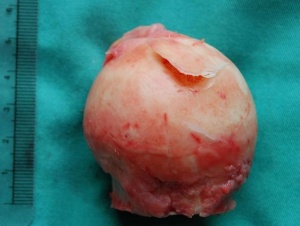Avascular Necrosis Femoral Head
Original Editor Anouk Toye
Top Contributors - Lucinda hampton, Anouk Toye, Kim Jackson, Uchechukwu Chukwuemeka, Aarti Sareen, Admin and 127.0.0.1
Introduction[edit | edit source]
Avascular necrosis (AN) of the femoral head is a pathologic process that results from interruption of blood supply to the bone. Etiopathogenesis is not well understood. Femoral head ischaemia causes bone marrow and osteocytes death, resulting in the collapse of the necrotic segment eventually.
AN of the femoral head has often been described as a multifactorial disease. Risk Factors include:
- Genetic predilection[1]
- Corticosteroid intake[2]
- Alcohol
- Smoking
- Various chronic diseases [3] eg sickle cell disease, human immunodeficiency virus , hypercoagulable states, autoimmune disorders[4][5].
Diagnostic procedures[edit | edit source]
It is very important that avascular necrosis is diagnosed early in the disease process since the success of the treatment is related to the stage at which the treatment starts. Diagnosos be made with plain radiographs in moderate/late disease but MRI may be required to detect early or subclinical osteonecrosis.[4][5]
History and Physical Examination[edit | edit source]
Patients are often seen because of pain in the groin, but symptoms can also radiate to the knee or buttocks. On examination, there is usually a painful range of motion, especially on forced internal rotation[6]. It is also important to track any risk factors before the start of the examination. Investigators need to be wary of avascular necrosis in any patient who has pain in the hip, negative radiographic findings, and any of the risk factors, described above. The other hip must also be evaluated.
Management[edit | edit source]
The precise therapy used depends on many factors, with each patient being evaluated individually for best outcomes. Such factors include the age of the patient, level of pain/discomfort, location and extent of necrosis and comorbidities. Treatments are best implemented at the pre-collapse stage and include both operatives as well as non-operatives options. If left untreated, femoral head AN may lead to subchondral fractures within only 2 to 3 years. The management ranges from conservative to invasive. Conservative management includes physical therapy, restricted weight-bearing, alcohol cessation, discontinuation of steroid therapy, pain control medication, and targeted pharmacologic therapy, among others.
Generally,
- Non-operative treatments or core decompression are best for asymptomatic and symptomatic small to medium-sized pre-collapse lesions. Conservative managements are physical therapy, restricted weight-bearing, alcohol cessation, discontinuation of steroid therapy, pain control medication, and targeted pharmacologic therapy, among others.
- Medium to larger-sized lesions can have treatment with bone grafting (vascularized or non-vascularized), or osteotomies.
- If femoral collapse has occurred or acetabular involvement is present, arthroplasty is indicated.[7][8]
Core decompression is a surgical procedure that requires surgical drilling into the area of dead bone near the joint, reducing pressure, allows for increased blood flow. This aims to slows or stops bone and/or joint destruction.[9]
Physical therapy[edit | edit source]
Electrical stimulation has been shown experimentally to enhance osteogenesis and neovascularization as well as to alter osseous turnover.[6]
Three different methods can be described:
- Non-invasive pulsed electromagnetic-field stimulation
- Direct-current stimulation of the necrotic area through the insertion of an electrode at the time of a core decompression
- Non-invasive direct-current stimulation by capacitive coupling after a core decompression
Electrical stimulation remains experimental for the treatment of avascular necrosis of the femoral head. Additional study is needed to define the optimum dosage, application, and timing of treatment. [6]
References[edit | edit source]
- ↑ Adesina O, Brunson A, Keegan THM, Wun T. Osteonecrosis of the femoral head in sickle cell disease: prevalence, comorbidities, and surgical outcomes in California. Blood Adv. 2017;1(16):1287-1295.
- ↑ Xie XH, Wang XL, Yang HL, Zhao DW, Qin L. Steroid-associated osteonecrosis: Epidemiology, pathophysiology, animal model, prevention, and potential treatments (an overview). J Orthop Translat. 2015 Apr;3(2):58-70.
- ↑ Jaffré C, Rochefort GY. Alcohol-induced osteonecrosis--dose and duration effects. Int J Exp Pathol. 2012;93(1):78-9
- ↑ 4.0 4.1 Orthobullets Hip Osteonecrosis Available: https://www.orthobullets.com/recon/5006/hip-osteonecrosis(accessed 15.12.2022)
- ↑ 5.0 5.1 Mont MA, Jones LC, Hungerford DS. Non-traumatic avascular necrosis of the femoral head: ten years later. J Bone Joint Surg Am. 2006;88:1117-1132
- ↑ 6.0 6.1 6.2 Mont MA, Hungerford DS. Non-traumatic avascular necrosis of the femoral head. J Bone Joint Surg Am. 1995; 77:459-474
- ↑ Hsu H, Nallamothu SV. StatPearls. StatPearls Publishing; Treasure Island (FL), 2020. Hip Osteonecrosis. Available from:https://www.ncbi.nlm.nih.gov/books/NBK499954/ (Accessed 25 July 2020)
- ↑ Barney J, Piuzzi NS, Akhondi H. Femoral head avascular necrosis.Available:https://www.ncbi.nlm.nih.gov/books/NBK546658/ (accessed 15.12.2022)
- ↑ Standford medicine Core decompression Available: https://stanfordhealthcare.org/medical-conditions/bones-joints-and-muscles/avascular-necrosis/treatments/core-decompression.html (accessed 15.12.2022)








